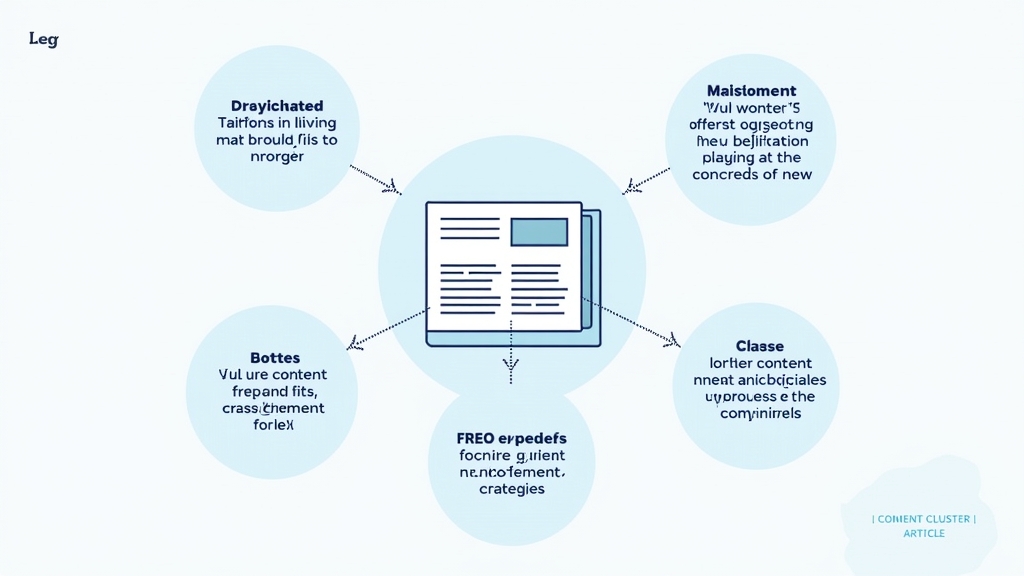Effective Marketing Strategies: Unlocking the Power of Content Cluster Strategies
Introduction
Understanding Content Cluster Strategies in Marketing
In today’s digital landscape, effective marketing strategies are essential for standing out. One powerful approach is using content cluster strategies. This method organizes your content around central themes, helping you rank higher on search engines like Google. By creating a network of related articles, you can establish authority and improve user experience. If you’re looking to enhance your online presence and attract more visitors, understanding how to implement content clusters can be a game-changer for your marketing efforts.
The Basics of Content Clusters
What are Content Clusters?
Content clusters are groups of related articles that revolve around a core topic or pillar page. The pillar page serves as the main hub, providing comprehensive information about the subject. Supporting articles dive deeper into specific aspects of that topic, linking back to the pillar page. This structure not only helps organize your website but also enhances SEO by signaling to search engines what your site is about.
The Importance of Topic Authority in SEO
Building topic authority is crucial for improving your site’s visibility on search engines. When you create well-researched and interconnected content clusters, it signals expertise in a particular area. Search engines prefer sites that demonstrate authority through relevant and high-quality content. As users engage with your material, they spend more time on your site—another positive signal for search engine rankings.
Building a Successful Content Cluster
Identifying Core Topics and Subtopics
To build an effective content cluster, start by identifying core topics relevant to your audience’s interests and needs. Think about what questions they might have or problems they want solved within your industry. Once you’ve pinpointed these topics, break them down into subtopics that can be explored in detail through supporting articles.
Keyword Research Techniques for Content Clusters
Keyword research is vital when developing content clusters. Use tools like Google Keyword Planner or SEMrush to find keywords related to your core topics and subtopics. Look for terms with high search volume but low competition; these will give you better chances of ranking well in search results. Incorporate these keywords naturally throughout both pillar pages and supporting articles.
Creating High-Quality Pillar Content
Characteristics of Effective Pillar Pages
An effective pillar page should be comprehensive yet easy to navigate. It must cover all aspects of the main topic while being engaging enough to keep readers interested. Include visuals like images or infographics to break up text and make information easier to digest. Additionally, ensure that it answers common questions related to the topic thoroughly.
How to Optimize Pillar Content for SEO
Optimizing pillar content involves several key practices: use targeted keywords strategically throughout the text without overstuffing; include internal links pointing towards supporting articles; utilize headings (H1, H2) effectively; and ensure mobile-friendliness for better accessibility across devices.
Developing Supporting Cluster Content
Types of Supporting Articles to Include
Supporting articles should focus on specific angles or questions related to the main topic covered in the pillar page. For instance, if your core topic is “Digital Marketing,” supporting articles could explore “Social Media Strategies,” “Email Marketing Tips,” or “SEO Best Practices.” Each article should provide valuable insights while linking back to the pillar page.
Best Practices for Interlinking within Your Cluster
Interlinking between cluster content is essential for guiding users through their journey on your site while enhancing SEO benefits too! Make sure each supporting article links back to its corresponding pillar page as well as other relevant pieces within the cluster—this creates a web-like structure that improves navigation and encourages longer visits.
Measuring the Success of Your Content Cluster Strategy
Key Metrics to Track and Analyze
To evaluate how well your content cluster strategy performs, track metrics such as organic traffic growth, average time spent on pages, bounce rates, and conversion rates from visitors who engaged with both pillar pages and supporting articles.
Tools to Monitor Performance
Utilize tools like Google Analytics or Ahrefs for tracking performance metrics effectively over time! These platforms help analyze user behavior patterns so you can adjust strategies accordingly based on real data insights rather than guesswork alone!
Overcoming Common Challenges in Implementing Content Clusters
Typical Roadblocks and Solutions
Some challenges may arise when implementing this strategy—like difficulty identifying suitable topics or maintaining consistent quality across all pieces produced! To overcome these obstacles consider conducting regular brainstorming sessions with team members focused solely on generating fresh ideas together!
Adapting Your Strategy Based on Analytics
Regularly review analytics data collected from monitoring tools mentioned earlier! If certain areas underperform compared against others—don’t hesitate making adjustments where necessary until optimal results achieved!
Conclusion
Recap of the Benefits of Using Content Cluster Strategies in Marketing
In summary, adopting content cluster strategies can significantly enhance your marketing efforts by establishing authority around key topics while improving SEO performance overall! By organizing information effectively through interconnected pillars & support materials—you’ll not only attract more visitors but also keep them engaged longer!
📢 Explore More: Continue Your Journey!
If this article helped you understand how powerful content clusters can be in marketing strategy development check out The Ultimate Guide To Keyword Research! It covers essential techniques that will help refine keyword targeting further enhancing visibility online.














![NEEWER 55W 18"/45cm Ring Light Kit [New Version], 5600K Dimmable ...](https://m.media-amazon.com/images/I/414QLqvZWLL._AC_.jpg)








